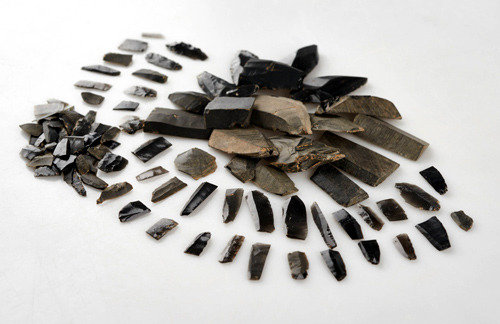Obsidian stones all the way to Daegu from Mt. Baekdu
Obsidian stones all the way to Daegu from Mt. Baekdu
Posted January. 18, 2017 07:10,
Updated January. 18, 2017 07:20

The Daegu National Museum introduced an analysis on the sources of 100 obsidian stones excavated in Wolseong-dong in Daegu in an academic paper. The ruins in Wolseong-dong excavated in 2006 produced the items from the late old Stone Age, the Bronze Age and the era of unified Silla altogether.
The museum said 97 out of 100 items turned out to be “Mt. Baekdu Type 1” after the analysis by Kim Jong-chan, a former physics professor at Seoul National University, who conducted laser ablation inductively coupled plasma mass spectrometry (LA-ICP-MS). There are three types of obsidian created in Mt. Baekdu and Type 1 and Type 2 are often found in the remains of the Old Stone Age in Korea. Obsidian stones were found in around 30 places in the Paleolithic ruins in Korea. The Wolseong-dong ruins produced the largest number of obsidian stones in southern Korea.
Despite a study on obsidian after discovery, it failed to identify the source as a breakdown analysis was not allowed to cultural heritage of the state. However, laser allowed a cutting-edge analysis method giving only damage of around 50 micrometer in diameter, making it available to analyze where they are from.
Obsidian stones from Mt. Baekdu were also found in Gyeonggi Province. Some raised a possibility that the original obsidian stones were extracted in Mt. Baekdu and later processed and moved all the way down to Daegu passing the center of the Korean peninsula. It is estimated that there was a trade network connecting the south and the north of the Korean peninsula in the late Stone Age era. “It is clear that Paleolithic people hunted and moved, it is still mysterious whether how they carried what through what path,” said Jang Yong-joon, a curator of the museum. “It carries a significant importance that Mt. Baekdu was found to be the source of obsidian stones in Gyeongsang Province.”
The paper also included the result of the experiment in which Kim Gyeong-jin, a professor of Perpignan University in France, tested the use. It shows that obsidian stones found in Wolseong-dong are estimated to have been used for chiseling animals’ bones or hunting.
Sang-Un Kim sukim@donga.com







